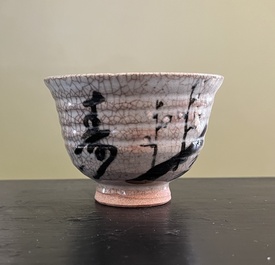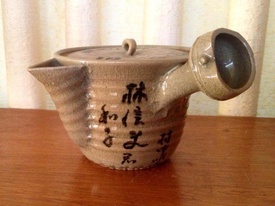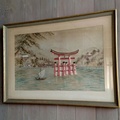When I arrived at The Plaza, I found Aunt Emiko watching a game show on a large TV in the community room. I was relieved that she recognized me right off and seemed elated for the company. “Let’s go to my room,” she said, “we’ll have more privacy there.”
In so many ways, Aunt Emiko seemed like her old self, my beloved aunt who had always made me feel like the most special person in the world, as if I could succeed in any endeavor I pursued. When I was in high school, she was the one I turned to when it seemed like neither my mom nor dad had any idea of the young adult I was becoming, a man who didn’t necessarily fit into the mold his parents had cast for him.
As a rebellious teenager, I had tuned them out and, whereas Dad was willing to back off and give me space, Mom only became more insistent that I hear what she was saying. And, unfortunately, any advice of hers became counterproductive, only spurring me in the opposite direction. “Mimi ga tou-i?” Mom would ask, slipping into Japanese, as she often did when she was exasperated: “Are you deaf?”
But my ears were always open to whatever Aunt Emiko had to say because she was the least judgmental person I’d ever known. And, whenever I confided in her, she implicitly knew what I needed most, whether it was a sympathetic ear or a swift kick in the butt. My kind, loving aunt was still basically the same person, but each time I visited she seemed increasingly hampered by the disease that was plundering her memory.
“How’s your mom and dad?” she asked.
Even though her children and I had repeatedly told Aunt Emiko about my parents’ passing, we had learned that it was now best to pretend otherwise. Why continually put her through the unnecessary pain of learning about the deaths of her baby brother and sister-in-law? So much kinder to let her live in her world of the past.
“They’re doing okay,” I replied, “but I was hoping you could help me with something. Do you know how to write Mom’s name in kanji?”
Aunt Emiko looked at me with a puzzled expression. “Why do you want to know?” she asked.
“I was just curious. Just wanted to know what her name might mean.”
“It’s Keiko, right?”
“Yeah, but there are eight different ways to write it.’” I dug out the photocopy from the priest and showed it to her.
“Hmmm,” Aunt Emiko said as she looked at the sheet. “I don’t know which one is your Mom’s. Maybe just ask her?”
“Well, I wanna surprise her. Her birthday’s coming up, and I want to have a collage made with ‘Keiko’ written in origami cranes.”
Aunt Emiko stared at the sheet again, trying to dig into her memory. “Sorry, but I don’t know. You see we would write to each other only in English. Try asking your dad. I’m sure he would know.”
On the drive back to my parents’ house, I tried not to think about my mom’s death. She had suffered unbearably from the stomach cancer that had spread so quickly, invading her body with brutal efficiency. She ended up losing a terrifying amount of weight, leaving her face looking so hollowed out and haunted. Thankfully, heavy dosages of morphine had helped manage her suffering in the last few days of her life.
Now that she had mercifully passed, a part of me thought that it might be a good distraction to start clearing her home and, anyway, the landlord was already asking when it would be vacant. The neighborhood rumor was that he wanted to level the small wooden house in order to build a two-story, multifamily “mansion” before the city of Honolulu passed an ordinance outlawing such structures.
Yet the more I thought about it, the more I dreaded the task ahead. It wasn’t just Mom’s belongings that I’d have to go through but also Dad’s because, even years after his death, she hadn’t touched a thing of his. Drawers were still filled with his t-shirts, socks, and underwear; half of their bedroom closet contained his suits, aloha shirts, and dress slacks. Any of those items would potentially be loaded with powerful memories — the one good, custom-made suit that Dad reserved for extra-special occasions; the many square, silk habotai scarves that Mom would so elegantly match with her outfits; the photo albums spanning decades; the souvenir tchotchkes we picked up on our many vacations, each one with a special story to tell.
Even the most mundane items had become a minefield. Just yesterday when I was packing up the kitchen, separating items to be donated to Goodwill versus those to be thrown out, I came across Mom’s manual eggbeater. The faded red handle and the oxidized metal rotary gear sent me quickly down a path of a memory of a long-ago birthday party when I turned seven. It was the first time my parents had allowed me to invite friends over for my birthday, and somehow I got it into my head that, instead of the sheet cake with custom birthday decorations that Mom usually ordered from Swan Bakery in Kalihi, I wanted a homemade cake. I have no idea why I was so insistent that she bake me that cake, but I told her I wanted a chocolate dobash, made from scratch with pudding in the batter.
My mother was an excellent cook, especially when it came to Japanese cuisine. Her tempura batter was exquisitely light and crisp, her sukiyaki broth had just the right amount of umami, and her miso butterfish was always cooked to perfection, caramelized and just slightly burnt at the edges. But, as with many Japanese cooks, any baking beyond simple cookies and brownies was a mystery to her.
The night before my party, I woke late to the sound of someone clanging about. I peered into the kitchen to see Mom shoveling the contents from a cake pan into the garbage disposal.
“What are you doing?” I asked.
Startled, Mom turned toward me, her face knotted in frustration. “This one came out too dry,” she said. “Maybe I’m overbeating the batter. I don’t know. We might just have to get a cake from Swan Bakery.” The look of disappointment must have shown on my face, prompting her to add, “that was my third try and I really can’t go on wasting flour, sugar, and butter.”
I would like to think that I was grateful for the feast that my mother prepared the next day: the shrimp tempura, the maki sushi, and the teriyaki meat grilled outside on a hibachi. I’d also like to think that I appreciated her having a grab bag of goodies for each of my dozen or so friends to take home with them. And, moreover, I’d like to believe that I was aware of the money that she and Dad saved to buy me the gift I had been longing for—a brand-new, ten-speed Schwinn bicycle to replace the hand-me-down bike I had inherited from a neighbor. But, most importantly, I really would like to think that I fully appreciated the effort my mother put into trying to bake the perfect birthday cake for me when, really, any store-bought cake would have been just fine.
I would have liked to believe all of those things but, looking back at that memory, all that I could see was an ungrateful, disrespectful son who deserved nothing for his birthday except a long lecture about being appreciative for the roof over his head, the food he ate, and the parents who loved him without reservation. If the sight of a simple eggbeater had sent me down such a painful path, who knew what other distressing memories could be conjured by other seemingly innocent objects?
As I parked my car in the garage and entered my parents’ home, I summoned my strength for the work ahead. The problem was that it wasn’t just the individual eggbeaters and other items with their attached memories; it was the sheer volume of those belongings. One of my parents’ regular admonishments to me was, “mottainai!” which was uttered frequently and always with an exclamation point. Loosely translated as, “what a waste!” I would hear the phrase whenever I was about to discard anything that might conceivably be of future use or value.
Mom and Dad were of the Depression generation, so protective of whatever belongings they might possess, but it wasn’t just that. Having been born and raised in Los Angeles, they were rounded up and incarcerated during World War II in concentration camps for people of Japanese descent. At the time, they were allowed to bring with them only what they could carry. That experience deeply wounded them, and those scars remained even after they met, married, and moved to Hawaii, where they felt more secure among the larger population of Asians.
As far as I could remember, Mom and Dad saved virtually everything, not just orphaned dishes and utensils from different sets, but also the rubber bands that held the daily newspaper folded in three, the wrapping paper and ribbon from past gifts, and the glass jars that once held grape jelly, peanut butter, and other foods. These various items were often called into duty with novel responsibilities. The plastic containers that once held blocks of tofu became the repositories for rubber bands, and empty mayonnaise bottles now kept loose change efficiently divided into quarters, dimes, nickels, and pennies.
I didn’t yet have the strength to sort through the contents of my parents’ bedroom, so I figured I’d stick with the kitchen and finish that. My mother had so many beautiful platters, ultra-sharp Japanese knives, and other cooking utensils but, since my divorce, I was living in a one-bedroom condo with just a small galley kitchen. I had no room for any of those items and, anyway, I was used to living on a diet of takeout food and rarely cooked at home. Still, I could just hear Mom say, “Mottainai!” but I rationalized with myself that at least someone at Goodwill would be able to use what I had no room to keep.
After several hours, I finally got to the top shelf of the kitchen cupboard, where my parents kept some of their most prized possessions, including Dad’s 18-karat gold sake cup, given to him by his father, and a Western dinner set of exquisite china with an elegant bamboo pattern made by Noritake. These were precious items that my parents rarely ever used, reserved only for the most special of occasions.
I wrapped each of those pieces in newspaper and packed them carefully into a box that I would bring back with me to my condo. Finally, I came to a Japanese tea set: a clay teapot and five cups, all beautifully fired with a dark celadon glaze and elegant Japanese calligraphy. Each piece was so impossibly light, especially the teacups with such thin rims. As I admired the incredible craftsmanship of each piece, it struck me.
Every year, in the week between Christmas and New Years, Mom would undertake a massive cleaning of our house. This was all part of the Japanese tradition of osoji, or “big cleanup,” with the goal of purifying the home so that we could ring in the new year on the best foot forward. So the screens from all our windows with jalousie louvers had to be removed and taken outside to be dusted, washed with soap, and rinsed clean. The wooden floors had to be scrubbed down and waxed. And all the kitchen shelves had to be relined with new paper. We always did the top shelf of the kitchen cupboard last and, that being the final osoji task, Mom would take her time to savor the end of several days of hard work.
As we cleaned that top shelf, she would, without fail, tell me the story of that tea set, which was a wedding gift from her grandparents in Japan. Each of the pieces had been thrown by a master potter in Iwakuni, the village of her ancestors, and the calligraphy commemorated their marriage. “Just look at how beautiful the writing is,” she’d say with such pride. “This is the story of how Dad and I met in America, the bountiful land of prosperity where our parents—your grandparents—immigrated to in the early 1900s.”
As I now looked carefully at the teapot, it was difficult to make out any of the kanji because of the fancy artistry of the writing. It was like trying to read a letter in old English written centuries ago with ornate lettering. But then, using the photocopy the priest had given me, I found my mother’s name—Keiko—written ever so gracefully with each stroke so perfect in its placement, width, and depth. As it turned out, Mom’s “Keiko” meant “enlightening child.”
It was, perhaps, the most apt of the eight Keikos. The kanji for her “Kei” was an ideogram of someone pushing open the door of understanding, trying to let the light of wisdom stream through. It was something Mom had been trying to do for me throughout my life even as I resisted her efforts. But I had always heard her, not just every “mottainai!” she uttered. I reached for my cell phone to call the priest to inform him that I now knew which “Keiko” was the right one.
*This short story was originally published in The Baltimore Review (Winter 2021).
© 2021 Alden M. Hayashi







